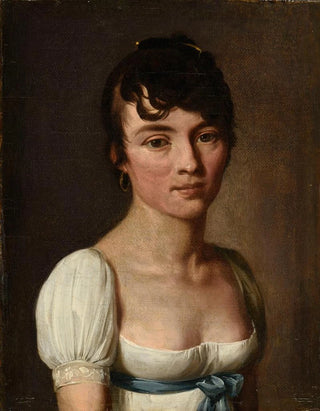Art print | Portrait of an anonymous woman - Louis Léopold Boilly


View from behind

Frame (optional)
Portrait of an anonymous woman - Louis Léopold Boilly – Captivating Introduction
In the vast panorama of art history, some works stand out for their ability to capture the very essence of humanity. The "Portrait of an anonymous woman" by Louis Léopold Boilly is a striking example. This piece, created in the early 19th century, does more than depict a female figure; it evokes an atmosphere, a period, and a sensitivity that transcend the simple act of painting. Through this portrait, Boilly invites us to delve into a universe where every detail, from the gaze to the clothing, tells a story — that of a woman whose identity remains mysterious. This mystery, far from being an obstacle, becomes an entry point into a deeper contemplation of the human condition.
Style and uniqueness of the work
Boilly's style is characterized by finesse in execution and meticulous attention to detail. In this art print, light plays a crucial role, illuminating the woman's face in a way that seems almost alive. Delicate shadows highlight her facial features, while the chosen colors evoke a soft and harmonious palette. The texture of the clothing, rich and elaborate, contrasts with the simplicity of the background, thus emphasizing the central figure. This stylistic choice enhances the impression of intimacy and authenticity. The woman's gaze, both direct and enigmatic, captures the viewer's attention and invites reflection on her thoughts and emotions. Boilly succeeds in creating an emotional connection, transforming this art print into a true mirror of souls.
The artist and his influence
Louis Léopold Boilly, an emblematic figure of the neoclassical movement, made his mark on his era through an innovative approach to portraiture. Born at the end of the 18th century, he navigated between influences of rococo and the beginnings of romanticism, forging a unique style that is his own. His ability to capture the psychological nuances of his subjects sets him apart from other artists of his time. Boilly was also a pioneer in using oil painting to depict scenes of everyday life, making art accessible and relevant to a broader audience. His influence endures, inspiring many

Matte finish

View from behind

Frame (optional)
Portrait of an anonymous woman - Louis Léopold Boilly – Captivating Introduction
In the vast panorama of art history, some works stand out for their ability to capture the very essence of humanity. The "Portrait of an anonymous woman" by Louis Léopold Boilly is a striking example. This piece, created in the early 19th century, does more than depict a female figure; it evokes an atmosphere, a period, and a sensitivity that transcend the simple act of painting. Through this portrait, Boilly invites us to delve into a universe where every detail, from the gaze to the clothing, tells a story — that of a woman whose identity remains mysterious. This mystery, far from being an obstacle, becomes an entry point into a deeper contemplation of the human condition.
Style and uniqueness of the work
Boilly's style is characterized by finesse in execution and meticulous attention to detail. In this art print, light plays a crucial role, illuminating the woman's face in a way that seems almost alive. Delicate shadows highlight her facial features, while the chosen colors evoke a soft and harmonious palette. The texture of the clothing, rich and elaborate, contrasts with the simplicity of the background, thus emphasizing the central figure. This stylistic choice enhances the impression of intimacy and authenticity. The woman's gaze, both direct and enigmatic, captures the viewer's attention and invites reflection on her thoughts and emotions. Boilly succeeds in creating an emotional connection, transforming this art print into a true mirror of souls.
The artist and his influence
Louis Léopold Boilly, an emblematic figure of the neoclassical movement, made his mark on his era through an innovative approach to portraiture. Born at the end of the 18th century, he navigated between influences of rococo and the beginnings of romanticism, forging a unique style that is his own. His ability to capture the psychological nuances of his subjects sets him apart from other artists of his time. Boilly was also a pioneer in using oil painting to depict scenes of everyday life, making art accessible and relevant to a broader audience. His influence endures, inspiring many






